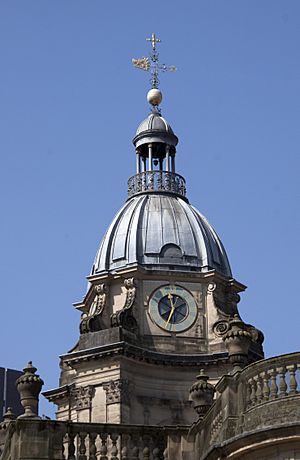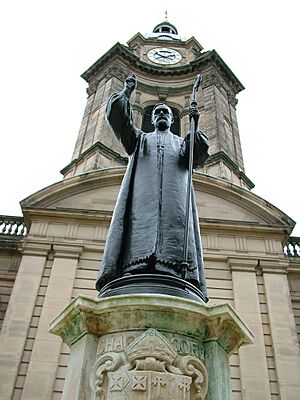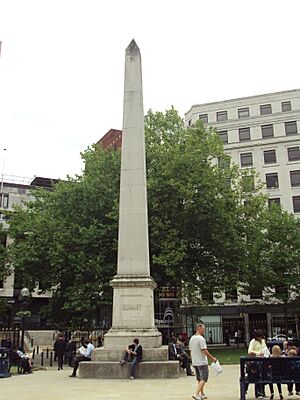St Philip's Cathedral, Birmingham facts for kids
Quick facts for kids Birmingham Cathedral |
|
|---|---|
| Cathedral Church of Saint Philip, Birmingham | |

The cathedral viewed from the south in March 2014
|
|
| 52°28′52″N 1°53′56″W / 52.481111°N 1.898889°W | |
| Location | Birmingham |
| Country | United Kingdom |
| Denomination | Church of England |
| Tradition | Anglo-Catholicism |
| Website | birminghamcathedral.com |
| Architecture | |
| Architect(s) | Thomas Archer |
| Style | Baroque |
| Years built | 1710-1725 |
| Administration | |
| Diocese | Birmingham (since 1905) |
| Province | Canterbury |
The Cathedral Church of Saint Philip is a special church in the Church of England. It's the main church for the Bishop of Birmingham, like a headquarters. This beautiful building was first built as a regular church in the Baroque style by Thomas Archer. It was officially opened in 1715. You can find it on Colmore Row in the middle of Birmingham. In 1905, St Philip's became the main cathedral for the new Diocese of Birmingham. It's also a very important historic building, listed as Grade I.
Contents
History of Birmingham Cathedral
How the Cathedral Was Started
St Philip's Church was planned because the old church nearby, St Martin in the Bull Ring, was too small. Birmingham's population was growing fast! A man named Robert Philips gave the land in 1710. This spot is one of the highest places in the area. It's even said to be as high as the cross on St Paul's Cathedral in London.
Building started in 1711 after a special law was passed. The church was designed by Thomas Archer. It was ready to be officially opened in 1715. It was named after the Apostle Philip to honor Robert Philips, who donated the land. This was one of Archer's first churches. Building was supposed to cost £20,000, but it only cost £5,012. This was because many building materials were given for free. St Philip's was a regular church from 1715 until 1905.
The church also had a library called the St. Philip's Parish Library. It was given to the church by William Higgs. In 1792, a special room was built for the library next to the church house.
Becoming a Cathedral
During the 18th and 19th centuries, many industrial towns grew very quickly. This meant more churches and a need for new main church centers. Birmingham became a city in 1889. Some cities like Liverpool built new cathedrals. But in other cities, older churches became cathedrals instead.
Thanks to the politician Joseph Chamberlain and the Bishop of Worcester, Charles Gore, St Philip's became the Cathedral of Birmingham in 1905. Charles Gore became its first bishop.
Birmingham Cathedral During World War II
During World War II, the cathedral was hit by bombs on November 7, 1940. It was badly damaged inside. Luckily, its most important treasures, which are beautiful windows by Edward Burne-Jones, had been taken out for safety early in the war. They were put back unharmed when the building was fixed in 1948.
Architecture and Design
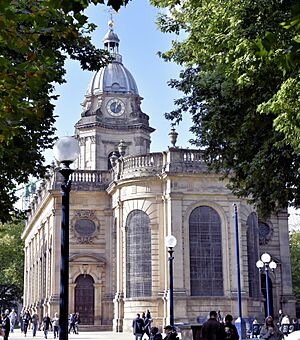
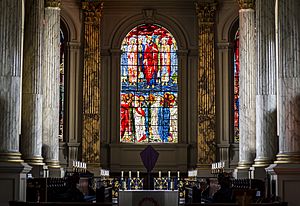
St Philip's was designed by Thomas Archer and built between 1711 and 1715. The tall tower was finished by 1725. Archer had visited Rome, and his design is in the Baroque style. It looks more Italian than churches designed by Christopher Wren.
Inside, the church has a rectangular shape. The main area, called the nave, has aisles on the sides. These are separated by pillars that support arches. Wooden balconies are built between the pillars, which was common in English Baroque churches.
Outside, there are tall windows between decorative columns. A railing runs along the roof with urns above each column. The west end has a single tower that rises in sections. It has a lead-covered dome and a delicate lantern at the top. The building is made of brick and covered with stone from Archer's own land.
The original eastern end was made bigger between 1884 and 1888 by J. A. Chatwin. This new part, called the chancel, has strong columns and rich decorations. Chatwin also replaced the stone on the outside of the building because the first stone was very soft. The tower was refaced again in 1958–59.
Edward Burne-Jones, a famous artist, was born nearby and baptized in this church. He gave several beautiful windows to St Philip's. Three of these are at the eastern end. The large window at the west end, also by Burne-Jones, was put in place in 1897 to remember Henry Bowlby.
Six of the monuments inside the cathedral are historically protected. These include memorials to people who died building Birmingham Town Hall and a memorial to the victims of the 1974 Birmingham pub bombings. A statue of Charles Gore, the first bishop, stands at the West entrance.
Cathedral Grounds
Outside the Cathedral, there is a large stone monument called an obelisk. It remembers Frederick Gustavus Burnaby. It has his picture and the words "Burnaby," "Khiva 1875," and "Abu Klea 1885." These refer to battles where he fought. He died in the Battle of Abu Klea. The obelisk was officially revealed on November 13, 1885.
Another red marble monument was put up in 1857. It remembers Lieutenant-Colonel Thomas Unett, who died leading his soldiers during the Siege of Sevastopol. After the Burnaby monument was built, it was decided not to add any more monuments inside the cathedral.
The grounds around the cathedral are often called "Pigeon Park" by local people.
Music at the Cathedral
The Organ
The organ in the cathedral is very old. Parts of it date back to 1715, when it was first built by Thomas Swarbrick. It has been repaired, made bigger, and updated many times. The most recent work was done in 1993. You can find more details about this organ at the National Pipe Organ Register.
Cathedral Bells
When the tower was finished in 1725, Joseph Smith made eight bells for it. Later, two more bells were added, making ten. These first bells were not very good. So, in 1751, the church decided to have them remade by Thomas Lester in London. The new bells were a bit bigger.
The bells were used a lot in the late 1700s and 1800s. However, by 1906, they could not be rung anymore because of worries about the tower's safety. They were briefly rung again in 1921. But by 1937, when there was a push to fix them for the King's Coronation, they had been unringable for years.
In 1937, the bells were remade and hung in a new metal frame. In 1949, two more bells were added, making a total of twelve bells that are still there today. In 2004, the bells were updated again. This included making the frame stronger and adding a viewing area.
Dean and Chapter
As of November 30, 2020:
- Dean – Matt Thompson (since September 30, 2017)
- Canon Precentor – Josephine Houghton (since May 11, 2019)
- Canon Missioner – Andy Delmege (since July 26, 2020)
See also
 In Spanish: Catedral de San Felipe de Birmingham para niños
In Spanish: Catedral de San Felipe de Birmingham para niños



